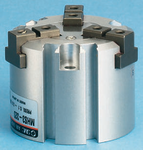Pneumatic Grippers
A pneumatic gripper uses compressed air to operate its jaws, also called fingers. These gripper fingers act a bit like human fingers by holding, handling, gripping the object into the required place. Most often these pneumatic grippers have 2 fingers (a parallel gripper or an angular gripper) or 3 fingers which use a single/ double acting cylinder for control purposes.There are 2 main types of gripper, the angular and parallel gripper. The parallel gripper being the most popular and most widely used due to their simplicity and ability to work with different dimensions.Common place for a pneumatic gripper is as part of an automation process, where individual items such as tiny semiconductors to much larger parts such as car engines are manufactured, equally grippers are often added to robotics to enable and assist them with pick and place work in particular as well as with other interactions.What advantages are there of a pneumatic gripper?The jaws have a high gripping potentialThe gripper is both lightweight and smaller in sizeLower costs are involved The gripper is easy to implement/ customise for application specific requirements





